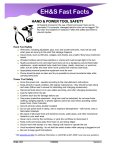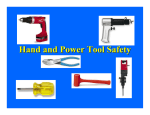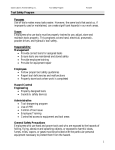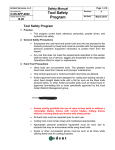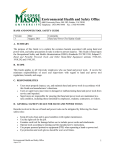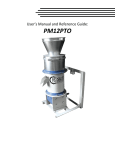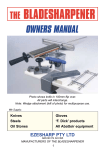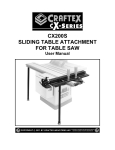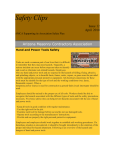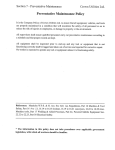Download Hand and Power Tools - (SEMS) Portal
Transcript
Section D Chapter 29 Hand and Power Tools Version: 0 Purpose The purpose of this procedure is to ensure that personnel operating or working with hand held or power tools take proper safety precautions to avoid or eliminate tool related hazards. Scope This safe work practice covers all Fieldwood Energy facilities and operations. Production operations, construction and well work activities shall abide by these requirements. Responsibilities The Person in Charge (PIC), Lead Operator, or Consultant is responsible for being knowledgeable of this SWP and enforcing the requirements as listed below. Requirements Hand Tools Hand tools are non-powered. The greatest hazard posed by hand tools are the result of misuse and improper maintenance. • Using hand tools in an improper manner (i.e. using a screwdriver as chisel) can cause handles to break and tool pieces to splinter. • Wooden handles, poorly maintained can cause tool heads to fly off, handles can splinter or crack. • Wrenches must not be used if jaws are sprung or worn, this could cause tool to slip off under pressure. • Impact tools (i.e. chisels, wedges) are unsafe if heads have mushroomed. These could shatter on impact creating flying fragments. • The employer is responsible for providing tools in safe condition; however, the employee is responsible for using and maintaining the tools properly. • Scissors and shears must be sharp, dull blades can be a hazard. • Steel or metal tools can be a source of ignition when working around flammable substances. Where this hazard exists, tools of wood, bronze, plastic or aluminum provide safety from sparks. Power Tools Power tools can cause serious injury when used incorrectly. Power tools may be activated by electrical, liquid fuel, hydraulic or pneumatic sources. Employees should be properly trained in use of power tools and safety precautions to prevent injuries. • Never carry a tool by cord or hose. • Never yank the cord or hose to disconnect from receptacle. • Keep cords away from heat, oil and sharp edges. • Disconnect tools when not in use, before servicing, and when changing accessories (i.e. blades, bits and cutters). • Avoid accidental starting, workers must be careful not to engage switch button while carrying a plugged in tool. Safe Work Practices Page D-29-0 Section D Chapter 29 Hand and Power Tools Version: 0 • • • • Proper apparel should be worn when operating power tools. Be aware that loose clothing, ties, or jewelry can become entangled in moving parts. All portable electrical tools that are damaged should be placed out of service and tagged “Do Not Use.” This includes grounding prongs on electrical cords and cut or frayed cords. Follow user’s manual for lubricating and changing accessories. Hand held power tools such as circular saws, and chain saws must be equipped with a constant pressure switch that will shut off the power when pressure is released. Power Tools and Hazards Electric Tools • The primary hazard of using electric power tools is the possibility of electrocution. Also, burns and minor electrical shock may be encountered. Even slight shocks can cause heart attacks. Shock hazard can also cause falls from elevated work platforms or ladders. • To protect users from shock, power tools must have a three wire cord with ground, and be grounded. Three wire cords contain two current carrying conductors and a grounding conductor. One end of the grounding conductor is connected to the tool’s metal housing. The other end is grounded through a prong on the plug. The third prong should never be removed from the plug. • General practices to be followed when using electric tools: a) Electric tools must be operated within design limitations. b) Gloves and safety footwear must be used. c) When not in use, tools should be stored in a dry place. d) Electric tools should not be used in damp or wet conditions. e) Work areas should be well lighted. Powered Abrasive Wheel Tools • Abrasive grinding, cutting, and wire buffing wheels create a special safety concern because they may throw off flying fragments. Abrasive wheels must constantly be checked for cracks or defects. To prevent cracking, the user should be sure the wheel fits freely on the spindle. The wheel should be appropriately tightened, but not so much that the flange is distorted. • Never stand directly in front of the wheel as it accelerates to full operating speed. Portable grinding wheels shall be equipped with safety guards to protect workers. • When using a powered grinder, always: a) Always wear goggles and face shield eye protection. b) Turn off power when not in use. c) Never clamp a hand held grinder in a vise. Pneumatic Tools Pneumatic tools are powered by compressed air. They include chippers, drills, hammers and sanders. There are several hazards associated with the use of pneumatic tools. Safe Work Practices Page D-29-0 Section D Chapter 29 Hand and Power Tools Version: 0 • There is a constant danger of coming into contact with the moving parts of the pneumatic tool (i.e. bits, abrasive bands). • Pneumatic tools that shoots nails, rivets, or staples operate at more than 100 lbs. per square inch must be equipped with a device to keep fasteners from being ejected unless the muzzle is pressed against the work surface. • Goggles and face shield are required PPE when operating pneumatic tools. Hearing protection should also be utilized. • The pneumatic hose should be attached by a positive means to keep the hose from being disconnected under pressure. A whip check attachment connected from the hose to the tool serves as an extra guard. • Compressed air guns should never be pointed at personnel. Hydraulic Power Tools The fluid in hydraulic power tools must be an approved fire-resistant fluid and retain operating characteristics at extreme temperatures to which it will be exposed. Manufacturer’s recommended operating pressure for hoses, valves, and filters must not be exceeded. General Safety Precautions Employees using power tools and exposed to hazards of falling, abrasive and splashed objects or exposed to dusts, fumes, mists or vapors must be provided with PPE necessary to protect them from these hazards. • Keep all tools in good condition with regular maintenance. • Use the right tool for its intended purpose. • Examine tools for damage before use. • Operate according to manufacturer’s instructions. • Provide and use proper PPE. Safe Work Practices Page D-29-0



